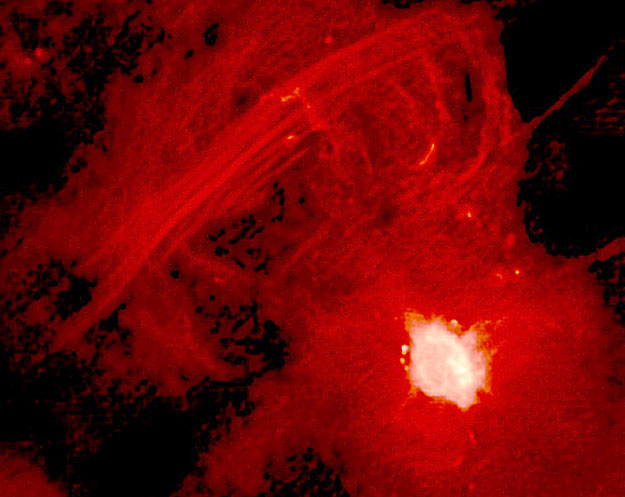
This light-year mosaic of several observatory images of the central region of our Milky Way galaxy reveals hundreds of white dwarf stars, neutron stars, and black holes bathed in an incandescent fog of multimillion-degree gas. A supermassive black hole at the center of the Galaxy is located inside the bright white patch in the center of the image. Dozens of massive stars, destined for a short but brilliant life, were born less than a light-year away from the Milky Way's central black hole, one of the most hostile environments in our galaxy, astronomers reported on Thursday. REUTERS/NASA
To: NormsRevenge
http://chandra.harvard.edu/photo/2005/sgra/
Chandra's image of the Galactic Center (left) has provided evidence for a new and unexpected way for stars to form. A combination of infrared and X-ray observations indicates that a surplus of massive stars has formed from a large disk of gas around Sagittarius A*, the Milky Way's central black hole (illustration on right).
2 posted on
10/13/2005 3:00:25 PM PDT by
NormsRevenge
(Semper Fi ... Monthly Donor spoken Here. Go to ... https://secure.freerepublic.com/donate/)
To: NormsRevenge
Live fast. Die young. "James Dean" stars?
To: NormsRevenge
This is likely utterly naive, but if I understand the "communication" of gravity, it is instantaneous whether objects are juxtaposed or separated by a universe. Wouldn't black holes that are a light year apart tend to fall into one another over some astronomically short period of time?
If I understand the "elegant universe" correctly, we live in some weird curved structure. Never-the-less, I have always wondered what exactly is on the other side of the boundary of the universe?
4 posted on
10/13/2005 3:06:12 PM PDT by
stevem
To: NormsRevenge
WASHINGTON (Reuters) - Dozens of massive stars, destined for a short but brilliant life, were born less than a light-year away from the Milky Way's central black hole, one of the most hostile environments in our galaxy, astronomers reported on Thursday. I hate to disillusion people, but they have images of the galactic center now, and there isn't any sort of a "black hole" there. What IS there is a radio arc and it seems obvious enough to me that you'd not see the radio arc if there was any sort of a black hole there:

6 posted on
10/13/2005 3:24:22 PM PDT by
tamalejoe
To: NormsRevenge
I've said this before. Here's how the creation of these stars works:
Black holes don't just collect matter (as a result of their enormous gravity), they also radiate energy (see Hawking).
Think of this energy radiation as similar to lightning. Once a path opens up (in lightning through dialectric breakdown) a large amout of energy flows. In the case of black holes, this huge flow of energy to one location creates a new star.
You heard it here first. (Unless you read my earlier post on a different thread.)
Possible
7 posted on
10/13/2005 3:35:15 PM PDT by
possible
To: NormsRevenge
Big stars are born near Milky Way's black hole I thought they formed in Memphis in the early Seventies.
</rock snob joke>
FreeRepublic.com is powered by software copyright 2000-2008 John Robinson


